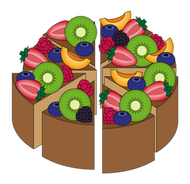B1.5 Use drawings and models to represent, compare, and order fractions representing the individual portions that result from two different fair-share scenarios involving any combination of 2, 3, 4, 5, 6, 8, and 10 sharers.
Activity 1: The Birthday Cake
Tell students that you want to make a cake this weekend for two friends who are celebrating their birthdays at the same time.
Tell them that you are going to decorate the cake with fruit. However, one of your friends loves raspberries and the other loves blueberries.
Ask students to give you ideas for decorating the cake.
Accept students' ideas.
Illustrate the cake or decorate a real cake with the fruit.
Ask students to identify the fraction represented by the raspberry part and the fraction represented by the blueberry part.
Show students how to write one half in symbols. Say that the 1 represents one part of the cake and the 2 represents the number of equal parts of the cake.
Provide students with cardboard, stickers and/or stamps, chalk, paint, and so on, and ask them to decorate one half of a cake with a filling of their choice and the other half with another filling.
Later, to present the fraction \(\frac{1}{4}\), repeat the activity, but decorating the cake with four kinds of fruit: \(\frac{1}{4}\) strawberries , \(\frac{1}{4}\) blackberries, \(\frac{1}{4}\) apricots and \(\frac{1}{4}\) kiwis.
Next, present the fraction \(\frac{1}{3}\) by repeating the steps.
Keep a picture of the three cakes to compare the size of the fractions.
Take one of the cakes and reproduce it three times. Divide one into two, another into three and the last into four equal parts. Ask students which piece they would prefer to eat: \(\frac{1}{2}\), \(\frac{1}{3}\) or \(\frac{1}{4}\).
Continue the activity by having students fill cakes according to your criteria.
Example

Keep a picture of the three cakes to compare the size of the fractions.
Variation
Use examples of pizzas or muffins instead of cakes.
Use other fractions, such as fifths, sixths, and eighths, to divide the cakes.
Source: translated from L'@telier - Ressources pédagogiques en ligne (atelier.on.ca).
Activity 2: Estimation
It is important for teachers to provide students with opportunities to estimate quantities represented by fractions in order to develop this skill.
Examples
Present a painting to students and ask them to estimate the fraction of the painting that is painted green (red, blue, and so on).
Take advantage of a situation such as a schoolyard gathering and ask students to estimate the fraction of the group made up of people who have black hair, blond hair, and so on.
Present various models representing a fraction (see illustrations below) and invite students to estimate the value of the fractions presented and justify their estimate.

Show students pictures that represent different wholes, as shown below, and ask them to approximate a given fraction (for example, \(\frac{3}{4}\)) without partitioning.

Source: translated from Guide d'enseignement efficace des mathématiques de la 4e à la 6e année, Numération et sens du nombre, Fascicule 2, Fractions, p. 44.
Activity 3: A Fraction Approaching
Ask students to name a fraction that is close to a whole number. Then ask them to find one that is even closer to that number and explain why they chose it. Continue the same process with other benchmarks (for example, near 0, near \(\frac{1}{2}\). Allow students to use a variety of tools (for example, concrete materials, number lines, relational rods, fraction sets) to find fractions and gradually encourage them to justify their answers with clear, convincing, and correct mathematical arguments.
Source: translated from Guide d'enseignement efficace des mathématiques de la 4e à la 6e année, Numération et sens du nombre, Fascicule 2, Fractions, p. 135
Activity 4: Comparing Fractions
Directions
Ask six students to divide themselves into two equal groups.
Ask the following question:
- What fraction of the whole does each group represent?
- Write this fraction on two cards and have one student from each group show it.
- How many students are there in each half?
Ask six other students to divide themselves into three equal groups.
Ask the following question:
- What fraction of the whole does each group represent?
Write this fraction on three cards and have one student from each group show it.
- How many students are in each third?
Point out that there are more students in one half of the first group (3 students) than in one third of the second group (2 students).
Ask six students to divide themselves into two equal groups.
Ask nine other students to divide themselves into three equal groups.
Proceed in the same way as above.
Point out that there are the same number of students in one half of the group of six students and one third of the group of nine students, namely, 3 students in each group.
Ask six students to divide themselves into two equal groups.
Ask twelve other students to divide themselves into three equal groups.
Proceed in the same way as above.
Point out that there are fewer students in one half of the group of six students than in one third of the group of twelve students.
Repeat by comparing \(\frac{1}{4}\) and \(\frac{1}{2}\) of 20 counters.
Note: Point out that the unit fraction (\(\frac{1}{2}\) of a set) always represents 1 group of a set divided into x equal groups, but that the fraction of a set represents a different quantity of elements depending on the number of elements in the set.
Teacher Instructional Moves to Provide Support
Continue the questioning used in explicit instruction.
Source: translated from Guide d’enseignement efficace des mathématiques de la 1re à la 3e année, Numération et sens du nombre, p. 56-57.
